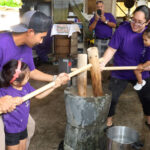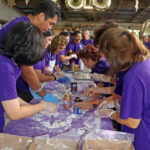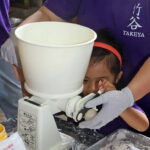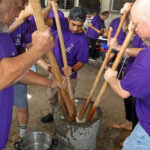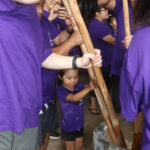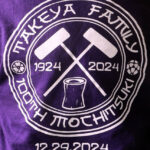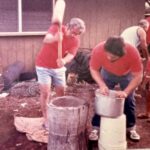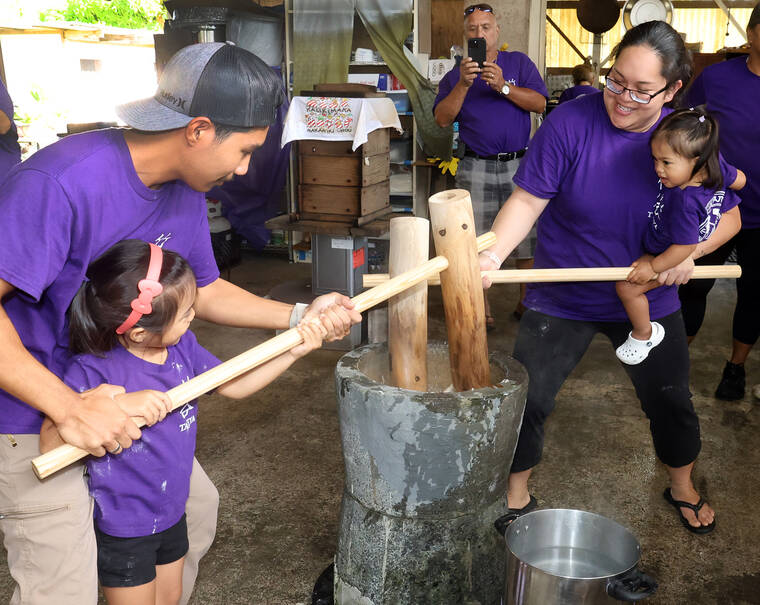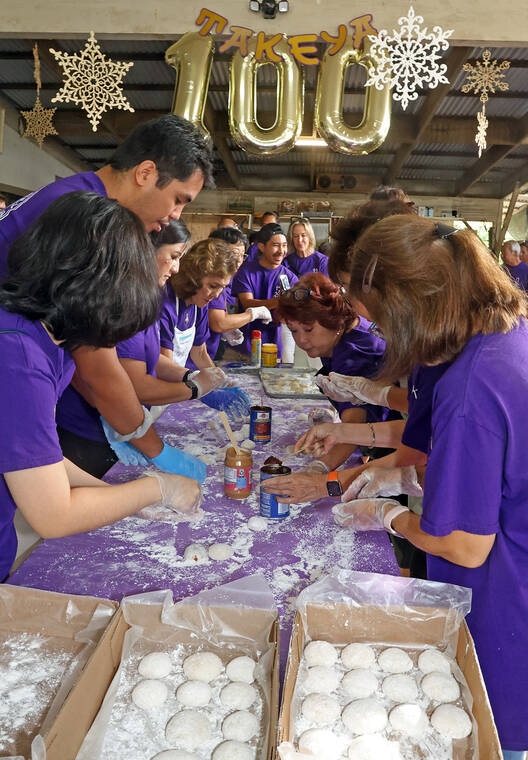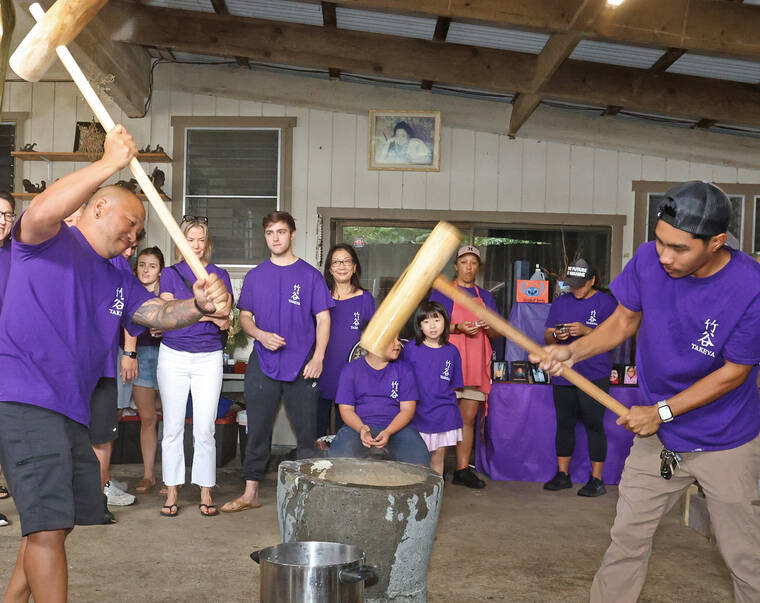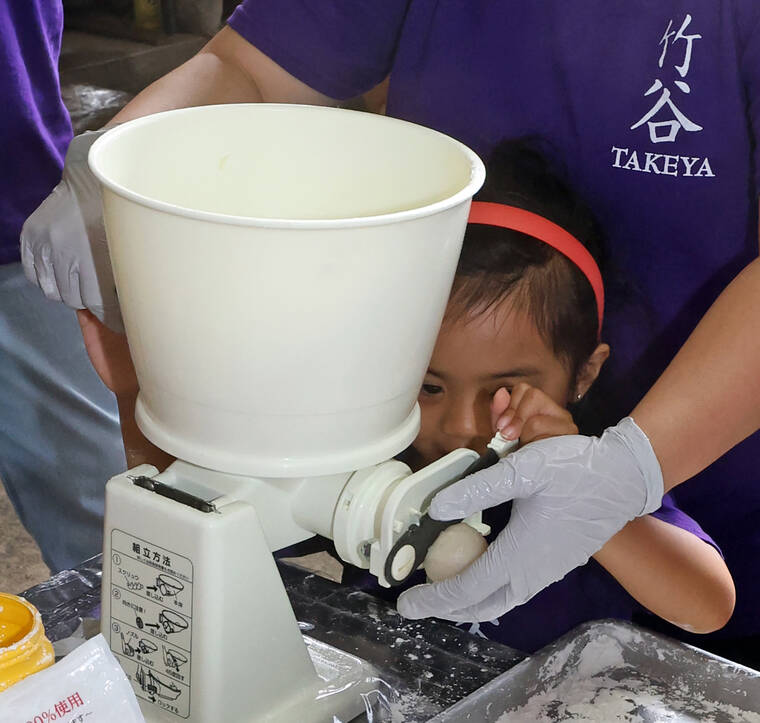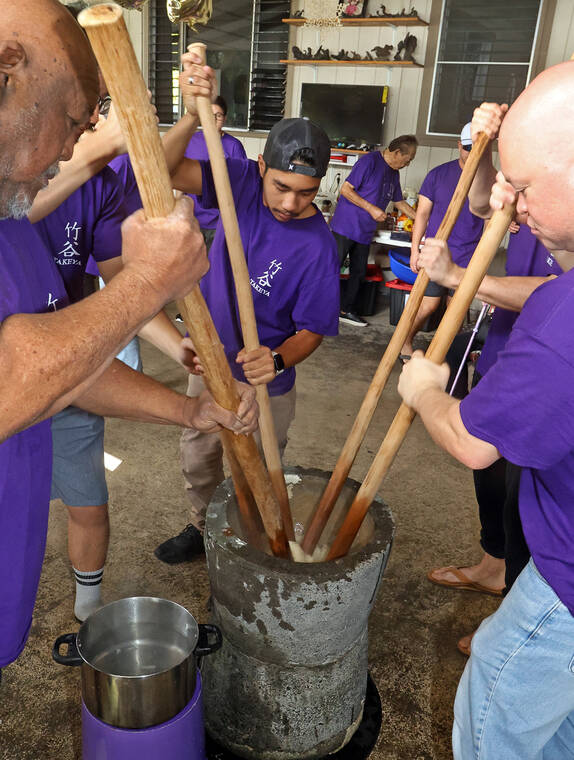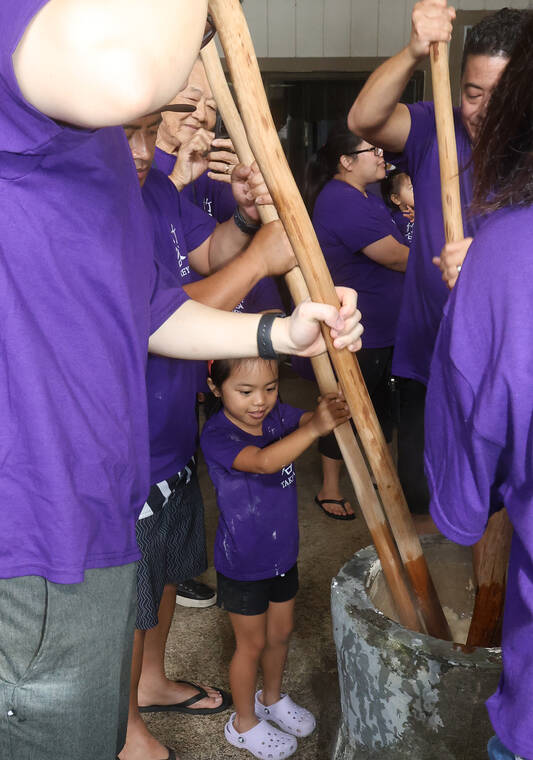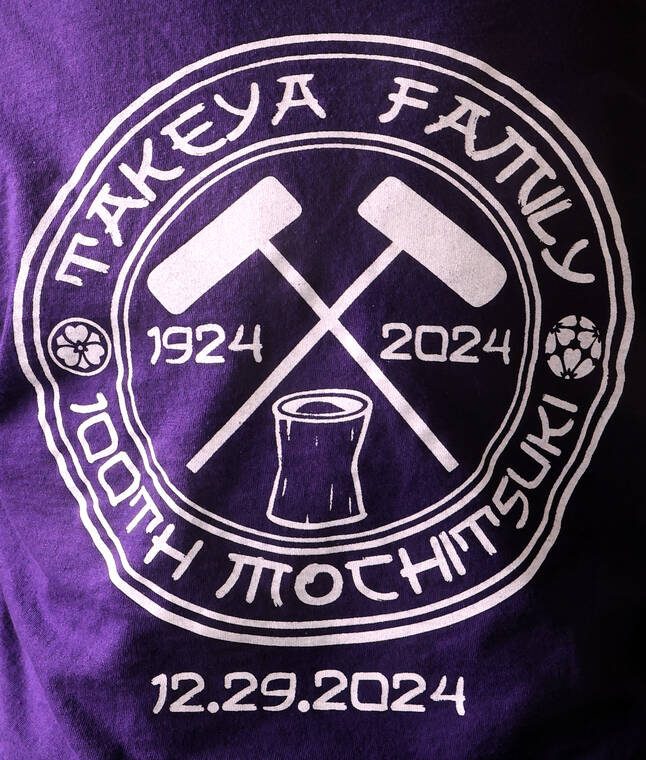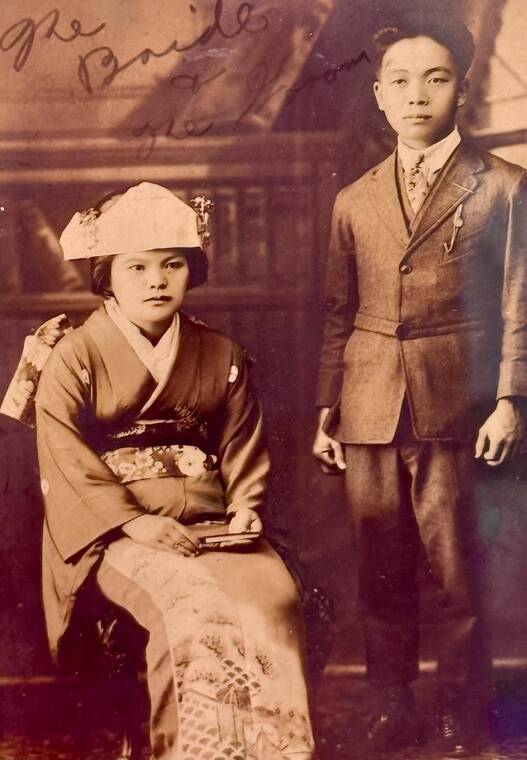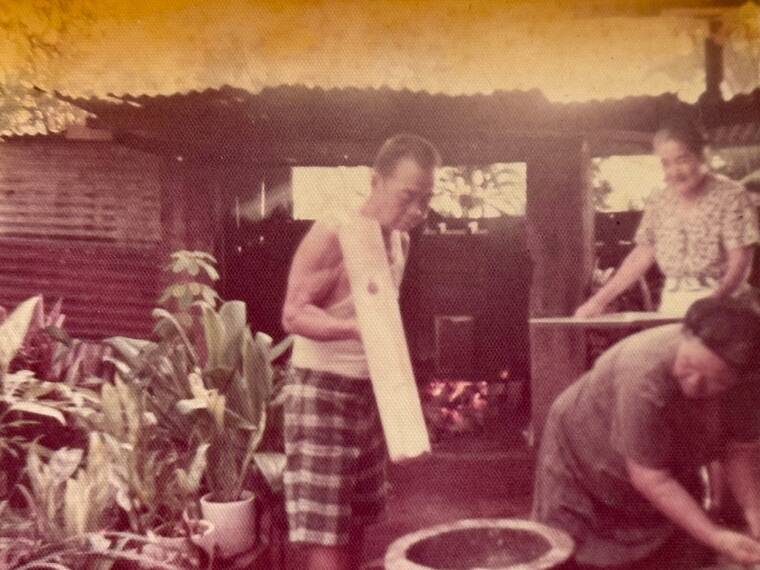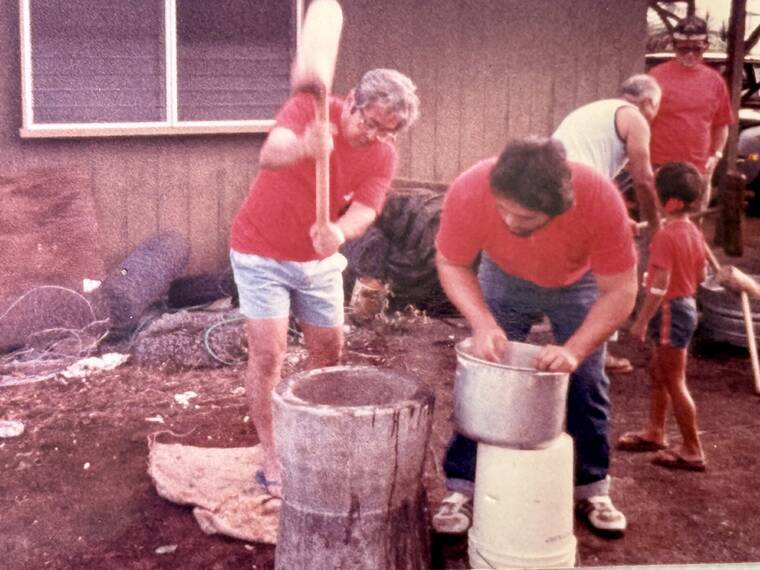Making mochi for the New Year is a tradition that’s observed by many of Hawaii’s families of Japanese ancestry.
One Hilo family, the Takeyas, on Sunday celebrated its 100th New Year’s mochitsuki — the ceremonial pounding of the sticky, glutinous rice into a pliable dough that’s then rolled into sweet rice cakes.
“We’re counting from the time my parents got married. They got married on Dec. 26, 1924,” said Gale Takeya, the 76-year-old daughter of Masao Takeya, the son of immigrants from Kumamoto, Japan, and Hatsumi Hiura, the daughter of immigrants from Hiroshima. “But actually, my father’s family came to Hawaii in 1902 and my father was born in 1904, so I’m sure they pounded mochi previously.”
The couple had 12 children. And each year since, usually on the weekend after Christmas, the Takeyas gathered with friends, neighbors and relatives and pounded mochi.
On Sunday, there were about 100 people — most, if not all wearing purple T-shirts designed for Sunday’s mochitsuki centennial — at the Panaewa home of Jodie Takeya, Gale Takeya’s niece.
“It’s for good luck,” Gale Takeya said of the ceremony. “Mochi is supposed to be a sticky rice. It starts out with grains of rice, and when it’s pounded together, it brings the family together.”
Including Masao Takeya’s parents, the Takeya family now numbers seven generations in Hawaii, and for the 100th anniversary mochi pounding, family members came from Oahu, Maui, Washington state, Florida and Nevada. Masao, Hatsumi, their parents, eight of their children, some of the grandchildren and a great-grandchild have passed on. But they are honored by the yearly mochitsuki, and the Takeya family legacy lives on.
“Because of the intermarriages over the years, there are more multicultural people than Japanese here,” Gale Takeya observed. The descendants of Masao and Hatsumi boast lineages including Native Hawaiian, Chinese, Filipino, Portuguese and Caucasian, as well as Japanese.
“It’s really nice, because we’ve got some family that came in from the mainland this year, that we hardly get to see, and off-island family that we hardly get to see,” said Jodie Takeya, who’s half-Hawaiian, and at 48, a fourth-generation scion of the Hawaii Takeyas.
Leona Chock, who’s 71 and Gale’s niece, lives in Honolulu.
“My dad was the oldest of 12 kids and Gale and Myrtle are the youngest two,” she said, referring to Myrtle Hara, a retired administrative executive secretary at the University of Hawaii at Hilo who is just a year older than her niece, Leona.
Asked if she comes to Hilo annually for the mochi pounding, Chock said, “I try to.”
“I’ve missed a couple. But this year, we’ve pretty much got the whole family,” she added.
Pam Chock, Leona’s stepdaughter, is originally from Kaneohe, Oahu, and graduated from Punahou School in 1979. One of her classmates was Barack Obama, who would become 44th president of the United States in 2009. She remembers him fondly and refers to him as “Barry.”
Now living in Orlando, Fla., Pam Chock helped other family members, mostly women, take the pounded mochi dough and roll it into discs on a long table dusted with cornstarch. Some of the mochi was rolled plain and transferred to a box. Other discs were stretched out and filled with either adzuki beans or chunky peanut butter before being boxed. She pointed to the concrete mortar with the mochi dough one man was buffeting with a wooden mallet while another man alternately mixed in a little hot water from a pan and folded the dough on the upswing of the mallet.
“The mortar that they are using is called an usu, and that one has been in use for 100 years,” Pam Chock said. “The mallet is called a kine, and they have to make one every couple of years because they get banged up, they get splintered. And if the splinters get into the mochi, no good.”
One of the relatives, Cayden Oshiro, made the kine used in Sunday’s mochi pounding.
Kawika Asam, Jodie Takeya’s nephew, is 35 but could easily pass for a decade younger. He moved to Oregon when he was 17 and has lived there the past 18 years.
“It’s my first time coming to this,” he said. “When we lived here, we lived down Puna side, so we never made it here for this. But aunty invited us this year. She invites us every year, but this is the first time we came.”
Asam, whose wife and two children also came to Hilo said it was his first time pounding mochi, as well.
“Aunt Jodie always does big things,” he said. “This family’s done a lot for the community and it’s nice to be able to come here, help out and experience what they do for New Year’s.”
Asam’s 11-year-old son, Kyron, met many of his relatives for the first time and also pounded mochi.
“It was fun. It was cool. Some hot water sprung back into my eye,” he said, referring to the water used to mix the dough while the pounding is going on. While mochi pounding can be dangerous, the youngster — who looked no worse for wear — said he’s fine.
Jodie Takeya said preparations for this year’s mochitsuki started more than a week ago with the washing of the pots used to steam the rice and the soaking and cleaning of the rice itself prior to steaming. She said the labor-intensive process is worth it for the fellowship as well as the final product.
“This is family and tradition,” she said. “I would like for it to be passed on to the next generation.”
Email John Burnett at jburnett@hawaiitribune-herald.com.
